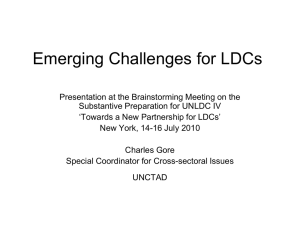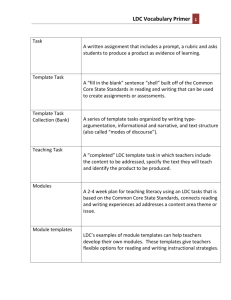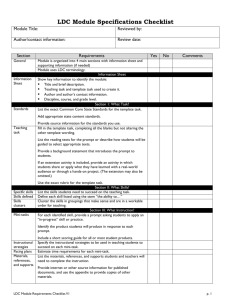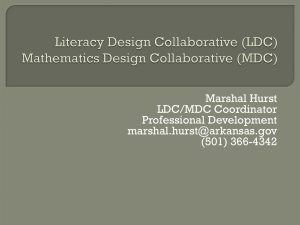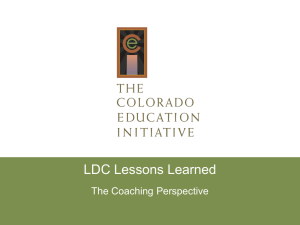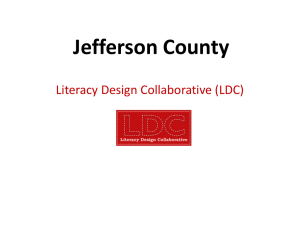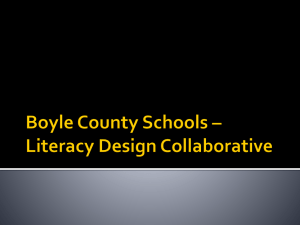Literacy Design Collaborative Rubric
advertisement
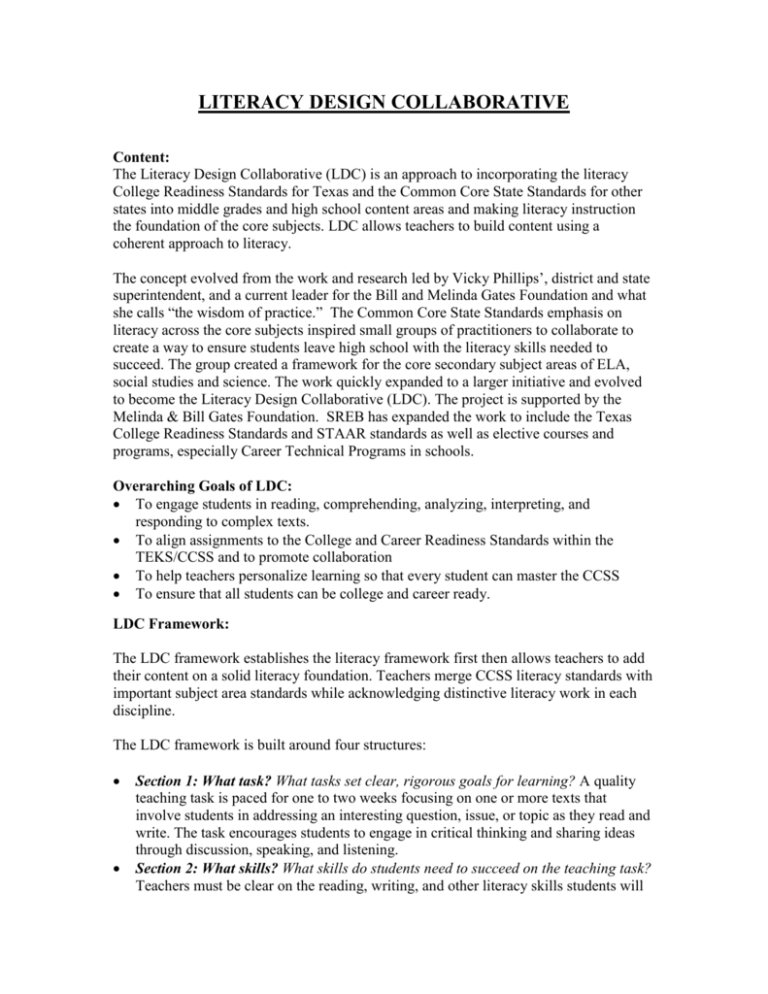
LITERACY DESIGN COLLABORATIVE Content: The Literacy Design Collaborative (LDC) is an approach to incorporating the literacy College Readiness Standards for Texas and the Common Core State Standards for other states into middle grades and high school content areas and making literacy instruction the foundation of the core subjects. LDC allows teachers to build content using a coherent approach to literacy. The concept evolved from the work and research led by Vicky Phillips’, district and state superintendent, and a current leader for the Bill and Melinda Gates Foundation and what she calls “the wisdom of practice.” The Common Core State Standards emphasis on literacy across the core subjects inspired small groups of practitioners to collaborate to create a way to ensure students leave high school with the literacy skills needed to succeed. The group created a framework for the core secondary subject areas of ELA, social studies and science. The work quickly expanded to a larger initiative and evolved to become the Literacy Design Collaborative (LDC). The project is supported by the Melinda & Bill Gates Foundation. SREB has expanded the work to include the Texas College Readiness Standards and STAAR standards as well as elective courses and programs, especially Career Technical Programs in schools. Overarching Goals of LDC: To engage students in reading, comprehending, analyzing, interpreting, and responding to complex texts. To align assignments to the College and Career Readiness Standards within the TEKS/CCSS and to promote collaboration To help teachers personalize learning so that every student can master the CCSS To ensure that all students can be college and career ready. LDC Framework: The LDC framework establishes the literacy framework first then allows teachers to add their content on a solid literacy foundation. Teachers merge CCSS literacy standards with important subject area standards while acknowledging distinctive literacy work in each discipline. The LDC framework is built around four structures: Section 1: What task? What tasks set clear, rigorous goals for learning? A quality teaching task is paced for one to two weeks focusing on one or more texts that involve students in addressing an interesting question, issue, or topic as they read and write. The task encourages students to engage in critical thinking and sharing ideas through discussion, speaking, and listening. Section 2: What skills? What skills do students need to succeed on the teaching task? Teachers must be clear on the reading, writing, and other literacy skills students will develop. These skills are identified by “back-mapping” from the requirements of the teaching task. All LDC modules must involve some form of reading and writing skills within clusters. Section 3: What Instruction? How will you teach students to succeed on the teaching task? Instruction is organized around teacher-ready “mini-tasks” or short classroom assignments that teach the skills necessary to complete the teaching task. . These mini-tasks create a formative assessment for monitoring what students are learning and provide opportunities for teachers to correct any misunderstandings or skill weaknesses students may have. All together, these features in the LDC system make up what is called an “instructional ladder.” Section 4-What Results? How good is good enough? Measuring student results is a hallmark of good instruction. It also provides a way for teachers to calibrate rigor levels so they have common understandings of expectations. The LDC framework provides rubrics for measuring student writing products – argumentative, informational/explanatory and narrative writing. Two examples of Tasks are provided: LDC Tasks vs. Traditional Writing Prompts: Science Task LDC Task Traditional Writing Prompt After researching the article on invasive species, Using examples we discussed in class, write an essay that defines invasive species and explain what humans are doing to explains how these organisms impact an negatively impact the environment. ecosystem, economy and people. Support your discussion with evidence from your research. (Informational) ELA Task LDC Task After researching speeches which use persuasive techniques, write a report that defines persuasion and explains its impact on an audience. Support your discussion with evidence from your readings. (Informational/Explanatory) Traditional Writing Task Using the notes in your journal, write an essay about the techniques writers use to persuade an audience. As a result of the professional development, teachers learn to develop tasks using the LDC Design Templates. By using the templates, teachers align the assignments to the TEKS/College Readiness Standards and STAAR Standard and address their specific content needs. After task development, teachers use the backward design planning format to create instructional modules (units) to best prepare students to complete the tasks. Modules include instructional strategies that embed literacy in learning the content of the courses. Simply stated, professional development results in teachers developing units of study that align to specific tasks that are aligned to the college readiness TEKS standards. Structure: LDC development is built on a sequence of eight (8) days of professional development for an initial group of teacher facilitators from each of the following content areas: ELA, Science, Social Studies, CTE and/or Arts as well as building administrators and other instructional leaders. Days 1 and 2 of training will occur on consecutive days. Teacher facilitators will select a “buddy teacher” after completion of a Task 2 and assist “buddy teacher with developing and implementing the task. The goal is for each teacher facilitator to develop and teach a minimum of two-three (2-3) tasks and modules) during the school year. “Buddy teachers” will develop and teach at least one task and module. The following sequence is planned for all facilitators. DAY TITLE OUTCOMES 1 Introduction Explore sample LDC tools (tasks, skill lists, instructional to ladders, modules). Construction Engage with teachers who have already implemented these of a Task ideas in their classrooms. Meet with a “crew” of three or four colleagues with similar teaching roles who can work together on future projects. 2 Teaching Use Template Task 2 to create a teaching task to use during the Task Design calendar’s first “teaching time.” Use Template Task 11 to create a teaching task to use during the calendar’s second “teaching time.” 3 A First Plan instruction, studying and revising each section of the LDC Instructional design team model ladder to work well with the first teaching Ladder task. Teachers teach a Task 2 after this day. 4 Scoring Student Work Reflect on the teaching experience. Score student work together, building deeper understanding of Skills and Ladders (with more variations) Plan instruction for a second teaching task, making greater use Scoring in Community Reflect on the teaching experience. Score student work together, building deeper understanding of 5 6 the LDC rubric. Choose sample student work to illustrate the results. of LDC flexibility. Teachers teach a Task 11 after this day. LDC rubrics and potential collaboration across subjects and levels. Choose sample student work to illustrate the results. 7 Module Completion Convert the work so far into LDC modules that other teachers can use or revise for their own teaching plans. 8 Deeper and Wider LDC Options Share and celebrate the tasks, modules, and student work created so far. Explore LDC options: sequences, courses, additional templates, and additional partners. Explore LDC expansion, including state and local scaling possibilities. Extension of Support (Content Coaching) SREB has learned that the rigor of the College Readiness and TEKS State Standards and the challenge of the tasks/modules are such a radical departure from the way teachers have used literacy in their classrooms that many teachers need additional support. SREB offers to extend all professional development workshop series by providing teacher facilitators with ongoing, job-embedded content coaching. Unlike workshops, content coaching involves the trainer working with teachers in their classrooms. Support may include, but is not limited to: Modeling instruction; Co-teaching; Peer observing; Planning LDC team meetings; or Other strategies to assist the teacher facilitators with implementation. Each school may choose to add Content Coaching for a specific number of days to the support. SREB recommends schools include at least one content coaching session between each workshop session.
